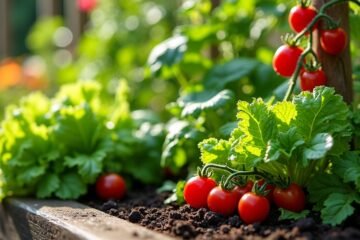Growing veggies in containers is like having a mini-garden right on your patio! Start by picking the perfect pots—clay has charm while metal screams urban chic. Choose compact varieties, like cherry tomatoes and leafy greens, to maximize your space. Use a soil mix of potting soil, compost, and perlite for happy, thriving plants. Don’t forget to water, feed, and check for pests. Ready to release your inner gardener and discover more tips? You’re in for a treat!
Choosing the Right Containers
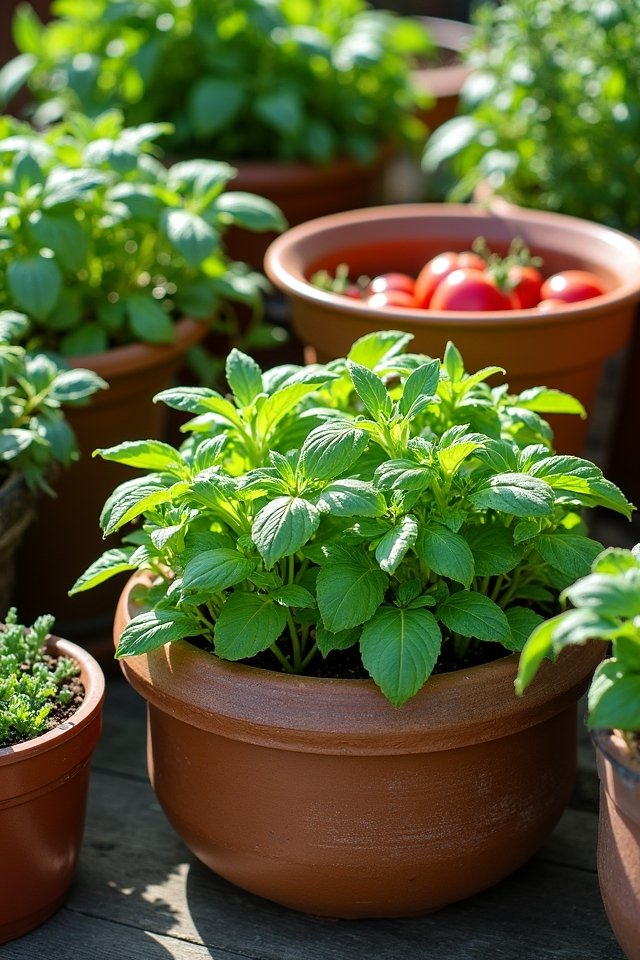
When you’re diving into the world of container gardening, choosing the right containers can feel a bit like picking the perfect outfit for a big date—it’s gotta look good and fit just right! First, consider your container materials: clay, plastic, or even recycled metal can bring unique vibes to your garden. For a chic urban look, go for sleek metal; for classic charm, clay is your best friend!
Next, size considerations are key. You don’t want your plants feeling cramped like they’re stuck in a tiny cubicle! A 12-inch pot works wonders for herbs, while larger veggies like tomatoes crave the space of at least 18 inches. Get creative; let your containers become beautiful extensions of your personality!
Selecting Suitable Vegetable Varieties
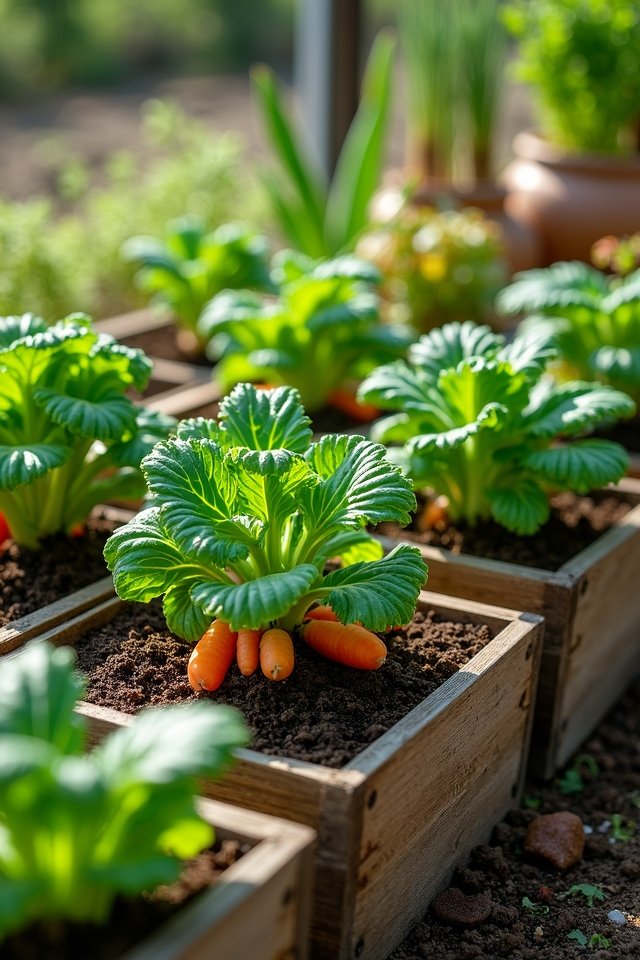
Selecting the right vegetable varieties for your container garden can feel like a delightful treasure hunt! You want to seek out compact varieties, those miniature marvels that thrive in small spaces. Imagine plump cherry tomatoes, bursting with sweetness, or vibrant, leafy greens that add a splash of color to your patio. Don’t forget heirloom selections! These historic gems, with their unique flavors and quirky shapes, can turn your garden into a conversation starter. Think about planting a rainbow of heirloom carrots alongside your compact zucchini. It’s all about creativity and innovation! By mixing these colorful options, you’ll craft a charming display that tantalizes both your taste buds and your senses. So, let the adventure begin—what’s your next edible delight?
Preparing the Soil Mixture
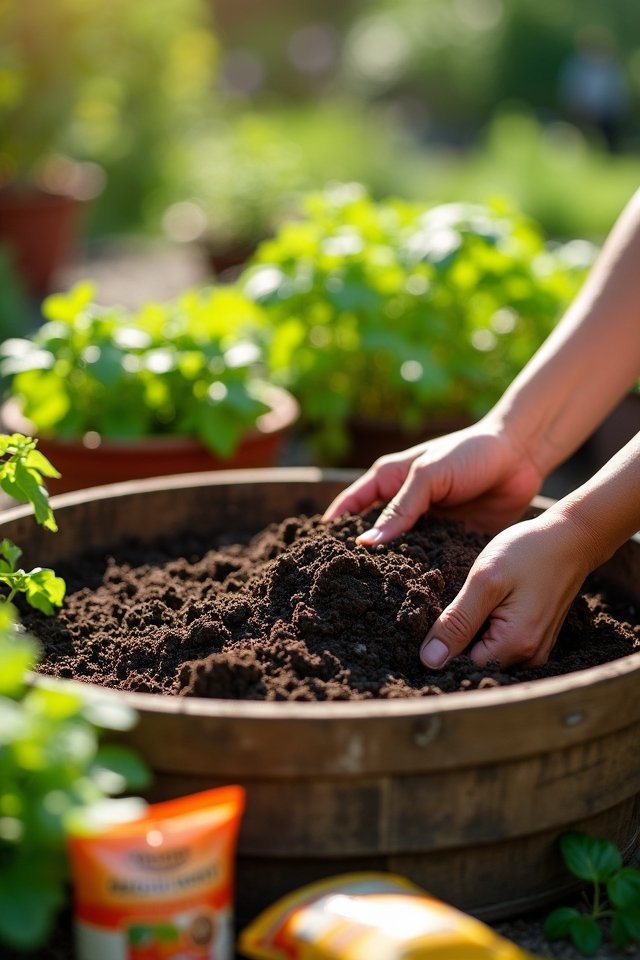
Getting the right soil mixture is essential for your container garden‘s success—think of it as the comfy bed where your veggies will dream big! First, blend various soil types like potting mix, compost, and perlite for that perfect texture. This combo promotes aeration and nutrient retention, so your plants can really thrive! Don’t forget drainage importance—no one wants soggy roots! Choosing a container with drainage holes is like giving your plants their own spa day! Curious about the proportions? Aim for equal parts potting mix and compost, adding a cup of perlite for extra fluffiness. Your veggies will thank you when they grow tall and lush, bursting with flavor! Who knew your green thumb could lead to such tasty adventures?
Watering and Fertilizing Your Container Garden
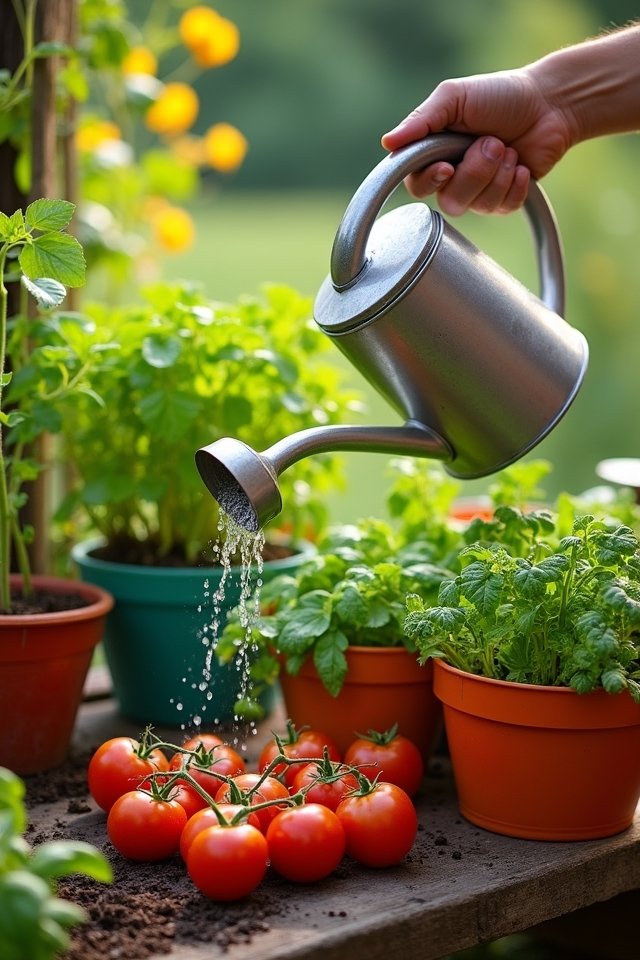
Watering and fertilizing your container garden can feel like a delightful dance between you and your plants. Imagine twirling around, making sure each pot gets the attention it craves! To master this waltz, focus on perfect drainage techniques—like adding perlite or gravel at the bottom of your pots. This prevents soggy roots and keeps your veggies happy.
When it comes to nutrients, aim for that golden nutrient balance! A slow-release fertilizer can work wonders, providing steady nourishment throughout the growing season. Don’t forget to monitor moisture levels; stick a finger in the soil! If it’s dry, it’s time to hydrate! With a little rhythm and a sprinkle of care, your container garden will flourish like a garden party in full swing!
Managing Pests and Diseases in Containers
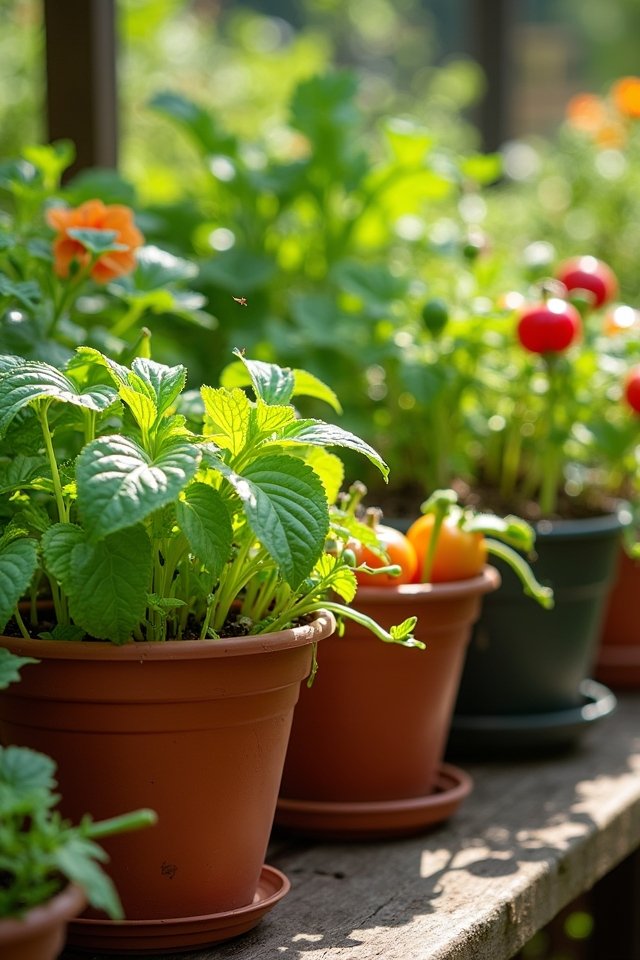
While your container garden may seem like a peaceful oasis, lurking pests and diseases can quickly crash the party! To keep your vibrant plants thriving, focus on pest identification and disease prevention. A proactive approach lets you enjoy the beauty of gardening without unwelcome guests. Grab your magnifying glass and remember:
- Inspect regularly for unusual spots, holes, or creepy-crawlies.
- Encourage beneficial insects like ladybugs; they’re nature’s little superheroes!
- Rotate your crops to confuse pests and break disease cycles.
- Use organic sprays like neem oil to vanquish pests with a green thumb’s flair!
Stay vigilant, act fast, and your container garden will flourish like the star it is! Happy gardening!
Frequently Asked Questions
Can I Grow Vegetables Indoors in Containers?
Did you know that indoor gardening can produce up to 20% more vegetables than traditional outdoor gardens? You can absolutely grow veggies indoors in containers! Just choose the right pots — think deep for tomatoes and shallow for herbs. Imagine the scent of fresh basil wafting through your kitchen! Start with easy favorites like lettuce and peppers. You’ll soon be amazed at how productive your little indoor garden can be. Isn’t it exciting?
How Much Sunlight Do Container Vegetables Need Daily?
Container vegetables usually need about 6 to 8 hours of sunlight daily. Think of sunlight as your plants’ morning coffee—absolutely essential! When you’re choosing container placement, look for a spot that basks in that golden light. You wouldn’t want to sip cold coffee, would you? So, if your veggies seem droopy or leggy, they might be craving more sunshine! Move them around, and watch them flourish like a sun-kissed summer day!
What Are the Best Container Materials for Gardening?
When it comes to container gardening, pick your pots wisely! Plastic containers are lightweight and budget-friendly, making them perfect for beginners. Terracotta pots offer a rustic charm but need regular watering. Metal planters bring style and durability, although they can heat up quickly. For the eco-conscious gardener, biodegradable pots blend seamlessly with nature. So, which will you choose? Each type has its perks, adding personality to your garden! Happy planting!
How Do I Store Harvested Vegetables From Containers?
After you’ve harvested your veggies, it’s time for clever storage solutions! Just like a treasure chest, a cool, dark pantry or fridge is perfect for keeping your fresh bounty. Remember to use breathable bags or baskets, letting your veggies “breathe” like a cozy sweater. If you’ve got a surplus, think drying or freezing! Who knew you could be an innovative veggie wizard? Your garden’s delicious gifts deserve the best home! Happy storing!
Can I Reuse Potting Soil From Last Year’s Containers?
Sure, you can reuse that potting soil, but it’s like an old pair of shoes—comfortable, but could use some sprucing up! For soil rejuvenation, mix in fresh compost to boost nutrient retention. Add a handful of worm castings for that extra oomph! Just remember, tired soil can lead to sad plants. Give it some love, and you’d be surprised how much life it can hold. Ready to give those veggies a second chance?
